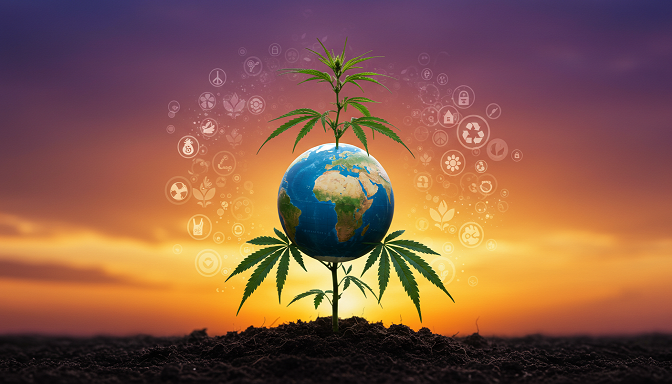
The Environmental Impacts Of Growing Cannabis (For Or Against)
Share
Cannabis is a plant that has been around for centuries and people are using it for both medical and recreational purposes.
The use of cannabis is highly debated, with some arguing that the environmental impacts of growing cannabis are too high.
In contrast, others maintain that the benefits of cannabis outweigh any potential environmental effects.
This guide will explore the environmental impacts of growing cannabis for and against it. Ultimately, it is up to each individual to decide whether or not to use cannabis based on the information presented here.
So, the question that arises by many users is, Is cannabis environmentally friendly?
To find out that, keep reading the blog!
We will explore the environmental impacts of growing cannabis in this article.
Background Of Cannabis Cultivation

Cannabis is an annual, dioecious, flowering herb. The leaves are palmately compound or digitate, with serrated leaflets.
The first pair of leaves usually have a single leaflet, gradually increasing to a maximum of thirteen leaflets per leaf (usually seven or nine), depending on variety and growing conditions.
At the top of a flowering plant, this number again diminishes to a single leaflet per leaf. The lower leaves are usually opposite, simple, and no more than 20 cm (8 in) long, with serrated leaflets. Up the main stem, leaves become alternate and progressively smaller until they are reduced to small bracts at the top.
The flowers are small and greenish-white, with five-lobed and divided calyxes. The corollas are two-lobed and divided. Male flowers have filaments that are fused into a tube. Female flowers have short styles with swollen bases ("pistils").
The fruit is a thin-walled, multi-seeded nutlet that breaks open at maturity.
Humans have cultivated cannabis since at least the 3rd millennium BC. It has been used for fiber (hemp), as a food source (hemp seeds), and as medicine (medical marijuana).
Industrial hemp products are made from cannabis plants selected to produce abundant fibre. To satisfy the UN Narcotics Convention, some cannabis strains have been bred to produce minimal levels of tetrahydrocannabinol (THC), the principal psychoactive constituent.
Some strains have been bred to increase yield and others for higher THC content. However, since THC production is a function of photosynthetic efficiency, breeding for higher THC content has generally reduced output.
The primary commercial source of cannabis is the Indian subcontinent.
What Are The Environmental Impacts Of Growing Cannabis? An Ultimate Guide.

Cannabis is used for many purposes, recreational or medicinal. Its use has skyrocketed in recent years, leading to the need for better methods of cultivation.
When marijuana users buy their weed from shops, it's grown indoors with artificial light and a high amount of carbon dioxide (CO2), a greenhouse gas that contributes to climate change.
Hence, cannabis cultivation can have both positive and negative environmental impacts.
Negative Impacts Include
First and foremost, let's explore some of the environmental concerns opponents of growing cannabis have raised.
-
Ph Levels In The Soil Are Thrown Off
The first issue that is commonly mentioned is the effect that cannabis cultivation has on the pH levels in the soil.
When cannabis is grown, it releases compounds known as "organic acids", which change the pH of the soil from its natural state to somewhere around 6.0-7.0 (on a scale from 1 to 14).It is not necessarily harmful to everyone because plants need a certain amount of acidity in their soil for optimum growth. That being said, the change in pH can be catastrophic for certain plants, causing them not to grow and even die. -
Pesticide And Herbicide Use
Although cannabis plants naturally resist most pests, some growers still use pesticides and herbicides. This can pollute waterways, cause contamination of the soil, and harm wildlife. -
Fertilizer Use
Cannabis plants require a lot of nutrients, so growers often use fertilizers. This can pollute waterways and harm wildlife. -
Water Pollution
Cannabis cultivation can pollute waterways if farmers do not use chemicals properly.For example, runoff from fertilizers and pesticides can pollute rivers and lakes. -
Soil Erosion
Another common complaint about growing cannabis on farms is that it is destructive and can cause harmful effects on the environment.The damage to soil caused by cultivation seems drastic, but in reality, the impact on the environment is minor compared with other factors such as pollution or fossil fuels.Erosion can lead to the loss of topsoil, which is essential for plant growth. -
Habitat Destruction
Cannabis cultivation can destroy natural habitats if the land is not managed correctly.For example, Clearing land for cultivation can lead to the loss of trees, flowers, and other plants. This can reduce biodiversity and disrupt ecosystems. -
Carbon Emissions
Cannabis cultivation emits carbon dioxide, which is a greenhouse gas. Greenhouse gases contribute to climate change. -
Air Pollution
Cannabis cultivation can emit pollutants such as dust and mold into the air. These pollutants can cause respiratory problems, especially for people with allergies or asthma. -
War On Wildlife
Cannabis farmers have been known to set up illegal plantations on protected lands. This situation can lead to the destruction of natural habitats and the displacement of wildlife. -
The Energy
Cannabis cultivation utilizes a lot of energy; when you are dealing with an industry primarily based on indoor cultivation and use, this can be attributed to the heat generated by these lights.As it turns out, the solar panels used for growing cannabis do not only contribute to the waste of energy but also the destruction of our environment at large.When these solar panels are installed on rooftops, they produce harmful radiation on a large scale and destroy many species like bees, butterflies, and birds -
Pest Problems
Cannabis cultivation can attract pests such as rats, mice, and insects. These pests can damage crops and spread disease.
Negative Impacts Include

Besides negatively impacting the environment, cannabis cultivation also has some positive effects.
-
Increased Carbon Sequestration
Cannabis plants are very efficient at sequestering carbon dioxide from the atmosphere.One study found that a single cannabis plant can sequester up to 22 pounds of carbon dioxide annually. This is a significant amount, considering that the average person emits about 17 pounds of carbon dioxide per day. -
Reduced Water Usage
Cannabis plants are relatively drought-tolerant and require less water than other crops such as corn or wheat. One study found that cannabis cultivation uses about 50% less water than traditional agriculture. -
Reduced Chemical Usage
Cannabis cultivation generally requires fewer chemicals than other types of agriculture. For example, cannabis plants are naturally resistant to most pests, so pesticides are not needed. -
Soil Health
Cannabis cultivation can improve the health of the soil. Cannabis plants add organic matter to the ground, which helps improve its structure and fertility. In addition, the roots of cannabis plants help aerate the soil and increase its water-holding capacity. -
Biodiversity
Cannabis cultivation can promote biodiversity by providing habitat for beneficial insects, birds, and other animals.
Frequently Asked Faqs By Growing Cannabis Users
-
How Much Water Does Cannabis Cultivation Use?
Cannabis cultivation uses about 50% less water than traditional agriculture.
-
What Are The Negative Impacts Of Cannabis Cultivation?
The negative impacts of cannabis cultivation include pesticide and herbicide use, water pollution, soil erosion, habitat destruction, and carbon emissions. -
Is Cannabis Cultivation Terrible For The Environment?
The answer to this question depends on how the plants are grown and what chemicals are used. If done responsibly, cannabis cultivation can positively impact the environment. However, if not done carefully, it can also cause significant damage. -
What Are Some Of The Most Environmentally Friendly Ways To Grow Cannabis?
The most environmentally friendly ways to grow cannabis include using organic methods, minimizing chemical use, and choosing a location that will reduce soil erosion. -
How can I make my cannabis cultivation more environmentally friendly?
There are a few things you can do to make your cannabis cultivation more environmentally friendly: use organic methods, minimize chemical use, and properly dispose of waste products. -
Why Is It Legal To Grow Cannabis?
In the United States, cannabis cultivation is reasonably straightforward. You are not allowed to cultivate cannabis plants if you have not obtained a prescription for it from a doctor.While this isn't exactly a law, doctors are generally unwilling to prescribe the drug for medicinal use if the patient does not have at least one severe ailment or condition that would benefit from its use.The federal government has decided that it should be illegal for anyone to cultivate cannabis plants without a prescription, meaning that anyone growing them must obtain one before they start their operation.
It also means that someone who cultivates without a license or prescription can face serious legal repercussions as a result
of their actions.

A Debate On Environmental Impacts Of Growing Cannabis
Whether or not cannabis should be legal for cultivation is a hotly contested topic.
Cannabis cultivation can have both positive and negative impacts on the environment.
Some people argue that growing cannabis should be legalized to generate tax revenue and create new jobs. Others believe that the environmental impacts of growing cannabis are too significant to justify its legalization.
The environmental impacts of growing cannabis can be significant. As cannabis cultivation requires large amounts of water and electricity.
In addition, cannabis plants release large amounts of carbon dioxide into the atmosphere.
Cannabis cultivation also significantly impacts the environment in terms of deforestation. To grow cannabis, farmers often clear large areas of forest. This deforestation can lead to soil erosion, decreased biodiversity, and climate change.
But there are several ways to reduce the environmental impacts of growing cannabis. One way is to use more efficient irrigation systems. Another way is to use greenhouses or grow lights instead of clearing new forest areas.
However, the truth is that the environmental impacts of cannabis cultivation depend on how the plants are grown and what chemicals are used. If done responsibly, cannabis cultivation can positively impact the environment.
Yet, if not done carefully, it can also cause significant damage. Therefore, it is essential to be informed about the potential environmental impacts of cannabis cultivation before deciding on whether or not to grow cannabis.
Ultimately, whether or not the environmental impacts of growing cannabis are considered acceptable is a personal decision. Some people believe that the benefits of cannabis legalization outweigh the environmental costs.
Others believe that the environmental impacts are too significant to justify its legalization.

Conclusion
The cannabis industry has grown exponentially in recent years. With every passing day, more states are legalizing cannabis for medical purposes, while others have relaxed laws on recreational use.
However, this has led to an unprecedented increase in growing demand, which is putting a strain on our environment at large. Therefore, a long-term solution must be brought to the table which will allow cannabis users to practice responsible use without disrupting the delicate balance of our ecosystem.
Whether or not we like it, with every hit of weed, we contribute to destroying many species like bumblebees, butterflies, and birds.
Therefore, cannabis users must incorporate environmentally friendly practices like switching from traditional grow lights to LEDs and from synthetic fertilizers and pesticides to organic seeds to reduce their impact on the environment.
In addition, cannabis users should always advocate for legalization so that policymakers and governments across the globe can hear their voices. Only once these issues are addressed can we genuinely find a long-term solution.
What do you think? Is the environmental impact of growing cannabis acceptable? Or are the environmental costs too high? Let us know in the comments below.
